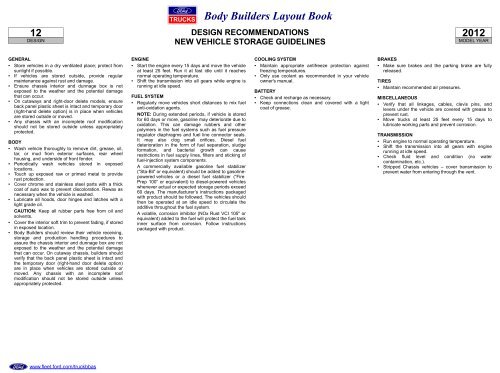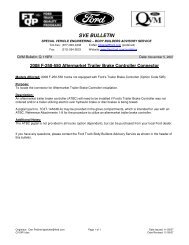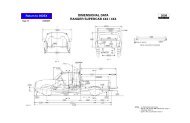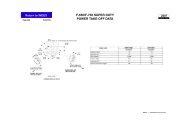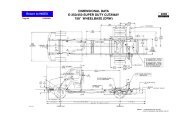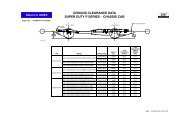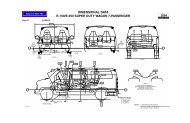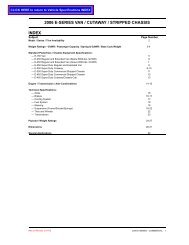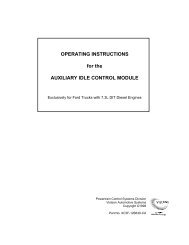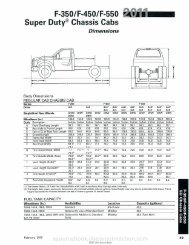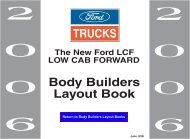Body Builders Layout Book - Ford Fleet
Body Builders Layout Book - Ford Fleet
Body Builders Layout Book - Ford Fleet
Create successful ePaper yourself
Turn your PDF publications into a flip-book with our unique Google optimized e-Paper software.
GENERAL<br />
12<br />
DESIGN<br />
● Store vehicles in a dry ventilated place; protect from<br />
sunlight if possible.<br />
● If vehicles are stored outside, provide regular<br />
maintenance against rust and damage.<br />
● Ensure chassis interior and dunnage box is not<br />
exposed to the weather and the potential damage<br />
that can occur.<br />
● On cutaways and right-door delete models, ensure<br />
back panel plastic sheet is intact and temporary door<br />
(right-hand delete option) is in place when vehicles<br />
are stored outside or moved.<br />
● Any chassis with an incomplete roof modification<br />
should not be stored outside unless appropriately<br />
protected.<br />
BODY<br />
● Wash vehicle thoroughly to remove dirt, grease, oil,<br />
tar, or mud from exterior surfaces, rear wheel<br />
housing, and underside of front fender.<br />
● Periodically wash vehicles stored in exposed<br />
locations.<br />
● Touch up exposed raw or primed metal to provide<br />
rust protection.<br />
● Cover chrome and stainless steel parts with a thick<br />
coat of auto wax to prevent discoloration. Rewax as<br />
necessary when the vehicle is washed.<br />
● Lubricate all hoods, door hinges and latches with a<br />
light grade oil.<br />
CAUTION: Keep all rubber parts free from oil and<br />
solvents.<br />
● Cover the interior soft trim to prevent fading, if stored<br />
in exposed location.<br />
● <strong>Body</strong> <strong>Builders</strong> should review their vehicle receiving,<br />
storage and production handling procedures to<br />
assure the chassis interior and dunnage box are not<br />
exposed to the weather and the potential damage<br />
that can occur. On cutaway chassis, builders should<br />
verify that the back panel plastic sheet is intact and<br />
the temporary door (right-hand door delete option)<br />
are in place when vehicles are stored outside or<br />
moved. Any chassis with an incomplete roof<br />
modification should not be stored outside unless<br />
appropriately protected.<br />
www.fleet.ford.com/truckbbas<br />
ENGINE<br />
<strong>Body</strong> <strong>Builders</strong> <strong>Layout</strong> <strong>Book</strong><br />
DESIGN RECOMMENDATIONS<br />
NEW VEHICLE STORAGE GUIDELINES<br />
● Start the engine every 15 days and move the vehicle<br />
at least 25 feet. Run it at fast idle until it reaches<br />
normal operating temperature.<br />
● Shift the transmission into all gears while engine is<br />
running at idle speed.<br />
FUEL SYSTEM<br />
● Regularly move vehicles short distances to mix fuel<br />
anti-oxidation agents.<br />
NOTE: During extended periods, if vehicle is stored<br />
for 60 days or more, gasoline may deteriorate due to<br />
oxidation. This can damage rubbers and other<br />
polymers in the fuel systems such as fuel pressure<br />
regulator diaphragms and fuel line connector seals.<br />
It may also clog small orifices. Diesel fuel<br />
deterioration in the form of fuel separation, sludge<br />
formation, and bacterial growth can cause<br />
restrictions in fuel supply lines, filters and sticking of<br />
fuel-injection system components.<br />
A commercially available gasoline fuel stabilizer<br />
(“Sta-Bil” or equivalent) should be added to gasolinepowered<br />
vehicles or a diesel fuel stabilizer (“Fire<br />
Prep 100” or equivalent) to diesel-powered vehicles<br />
whenever actual or expected storage periods exceed<br />
60 days. The manufacturer’s instructions packaged<br />
with product should be followed. The vehicles should<br />
then be operated at an idle speed to circulate the<br />
additive throughout the fuel system.<br />
A volatile, corrosion inhibitor (NOx Rust VCI 105" or<br />
equivalent) added to the fuel will protect the fuel tank<br />
inner surface from corrosion. Follow instructions<br />
packaged with product.<br />
COOLING SYSTEM<br />
● Maintain appropriate antifreeze protection against<br />
freezing temperatures.<br />
● Only use coolant as recommended in your vehicle<br />
owner's manual.<br />
BATTERY<br />
● Check and recharge as necessary.<br />
● Keep connections clean and covered with a light<br />
coat of grease.<br />
BRAKES<br />
2012<br />
MODEL YEAR<br />
● Make sure brakes and the parking brake are fully<br />
released.<br />
TIRES<br />
● Maintain recommended air pressures.<br />
MISCELLANEOUS<br />
● Verify that all linkages, cables, clevis pins, and<br />
levers under the vehicle are covered with grease to<br />
prevent rust.<br />
● Move trucks at least 25 feet every 15 days to<br />
lubricate working parts and prevent corrosion.<br />
TRANSMISSION<br />
● Run engine to normal operating temperature.<br />
● Shift the transmission into all gears with engine<br />
running at idle speed.<br />
● Check fluid level and condition (no water<br />
contamination, etc.).<br />
● Stripped Chassis vehicles – cover transmission to<br />
prevent water from entering through the vent.


